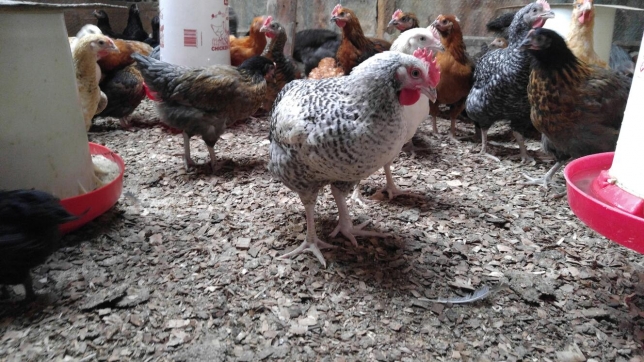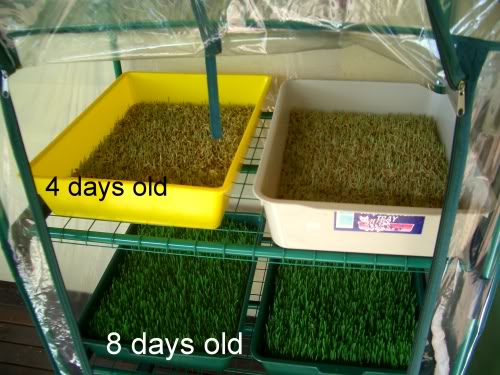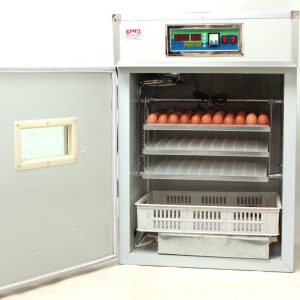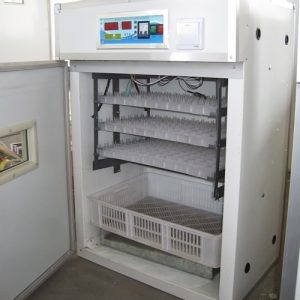Diseases may be defined as illness of one or more of the body organs or tissues, caused by pathogens or germs. Germs (virus, bacteria) and protozoa are classified according to size. Parasites, though not germs, can cause ill health. The significance of a disease depends on the rate of infection or infestation and the number of birds that die. Death rates depend on age and nutritional status.
Protozoa
Protozoa such as Emiria tenella (coccidia) are larger than bacteria hence more easily visible by microscope. Outbreaks of protozoan diseases are an indication of poor sanitation and hygiene.
Prevention and control
Vaccination and isolation of healthy birds from sick ones and proper disposal of dead birds can prevent diseases.
Vaccination
Vaccination is the use of mild, live or inactivated infective agent (virus or bacteria) to stimulate production of antibodies to a specific infective agent. Antibodies are chemical substances produced within the host body.
They recognise and destroy the virus or bacteria used during vaccination before onset of disease. Vaccines are prepared from the same virus or bacteria that cause the disease to be vaccinated against. They are sensitive to heat, pH (acidity) and therefore should be handled following manufacturers’ instructions
Vaccination programmes
Vaccination for indigenous chicken in a free-range system depends on age, disease incidence, severity and status of endemic diseases.
Disease | Species affected | Age affected | Symptoms | Treatment |
NCD | Chicken, turkeys & domestic birds | All | Depression, poor appetite, coughing and difficult breathing, diarrhoea, nervous signs, twisted neck and death in large numbers in a short time | Vaccination Antibiotics to control secondary infections |
Fowl pox | Chickenand turkeys | All but serious at point of lay | Spreading eruption on comb, wattle nose & other featherless parts, poor appetite/egg production, depression. Deaths may result in chicks | |
Infectious Bronchitis | Chicken | All | Chicks/growers: Depression, huddling, poor appetite, coughing, gasping/difficult breathing, death. Adult: Coughing/noisy breathing, few eggs laid/with soft shells | |
Avian Influenza | Chicken and turkeys | All | Depression, coughing, discharge from eyes/nostrils, swollen face, poor sight and feeding, nervous signs and diarrhoea | Destroy sick birds |
IBD | Chicken | 2-6 wk | Depression, poor appetite, unsteady walk, pecking at vent and diarrhoea | Control by vaccination |
Bacterial diseases
diseases that can be prevented through good hygiene and treated using antibiotics
such as Tetracycline.
Salmonella. There are 3 types of infection caused by the Salmonella microorganism.
These are pullorum disease, fowl typhoid disease and salmonellosis.
Pullorum disease caused by sub-species S. pullorum is fatal in chicks. It is transmitted from hen to chicks during egg formation, contamination of eggs at laying or the chicks are infected from faeces. Symptoms include dead embryo in eggs that do not hatch, chicks develop wet vents (tail) within the 1st week, whitish diarrhoea, huddling and difficulty in breathing. Mortality can reach 100% in the 1st 2 weeks.
Fowl typhoid is caused by the species S. gallinarum and is severe in growers and adult birds. It is spread by contamination of feed and water by faecal matter from infected birds. Symptoms include drop in egg production, egg fertility and hatchability, anorexia and dullness followed by sudden death.
Salmonellosis is caused by any other Salmonella species. It is severe in both chicks and adult birds. It is spread by contamination of eggs at laying or to both chicks and adults through contaminated feed, water and faeces. Symptoms include drop in egg production, egg fertility and hatchability, anorexia and dullness followed by sudden death.
Sanitation, and eggs and nest fumigation using formaldehyde pellets in the nest can prevent it. Broad-spectrum antibiotics such as sulphur drugs can control infections. Control is by vaccination
Collibacillosis is acute in chicks and chronic in adult chicken. It is transmitted through eggs to chicks and through contaminated faeces, feed and water to both adult birds and chicks. Symptoms include respiratory distress, diarrhoea and high mortality in chicks while those in embryonic infection include dead embryos in spoiled eggs. It can be avoided by maintaining standard egg sanitation and using broad-spectrum antibiotics such as sulphur and tetracycline to treat and to reduce transmission. It can be controlled by vaccinating with bacterin.
Infectious Coryza can be acute, mild or chronic. It is spread by faecal matter, aerosols or through contaminated feed and water. Symptoms include swollen watery eyes, nasal discharge, laboured breathing and drop in egg production. It can be prevented by vaccinating with bacterin in water at 10-12 weeks and 16-18 weeks. All clinically ill birds should be destroyed.
Disease | Species affected | Age affected | Symptoms | Treatment |
Salmonellosis Chicken, turkeys, ducks | Chicken, turkeys, ducks | Severe in chicks up to 3 months, moderate in adults | Dejection, ruffle feathers, dosing, huddle together in chicks, poor appetite, thirst, soiled vents, and high deaths | Vaccination Furazolidone sulphur drugs (SDime) |
Collibacillosis | Chicken, turkeys, ducks | 4-8 wk | Coughing, sneezing, dejection, poor appetite, poor growth | Antibiotics Furazolidone and Sulphur |
Infectious Coryza | Chicken | All | Swollen face, sneezing and difficult breathing, loss of condition, low egg production and variable death | Antibiotics |
Parasitic diseases
Parasites are organisms that live on others without benefit to the host and include worms living in the opening of organs, and lice and fleas on the external. The parasites may cause diseases, weakening the system so that other disease-causing agents thrive or transmit diseases. Worms are internal parasites that inhabit the alimentary canal and other internal organs such as provendriculus, gizzards, trachea, lungs. There are 2 groups of worms, round worms and flat worms
Round worms Ascridia galli infects both chicks and adult chicken. Eggs are laid by female worms in birds’ intestines and are passed out in droppings. They mature in one week or more after which they may be swallowed up by chicken, hatch and cause fresh infection. Clinical signs include slow growth (stunted), culled feathers and drooping head, thirst, low egg production and death due to intestinal obstruction
in young birds. Due to their feeding habits, it is difficult to prevent this condition in scavenging chicken.
Gape worms Syngamus treachea roundworms infect the trachea (windpipe) of chicken. Adult worms live and lay eggs in the birds’ trachea; the eggs may be coughed out or into the oesophagus and swallowed in which case the hen passes the eggs in stool. The eggs hatch to larvae which infect chicken or enter simple
carriers (intermediate hosts) such as beetles and earthworms. Symptoms include difficulty in breathing and gasping for air, hence the term gapeworm, culling and huddling and death due to suffocation. The condition can be controlled by giving Thiabendazole or Gapex in drinking water.
Tape worm Raillietina tetragona infests scavenging chicken. The worms pass eggs either as free eggs or retained in a segment. Intermediate hosts such as beetles and snails ingest the eggs or segments. The eggs develop in the host and in turn infect chicken that feed on the intermediate hosts. Symptoms include stunting, thirst, poor health, low egg production and death in young birds on poor diets. it is prevented in scavenging chicken by using clean containers and drenching at 3- month intervals with Albendazole and Fenbendazole.
Isolation disposal of dead birds
Do not introduce new birds purchased from markets or given as gifts directly in to the flock. Keep them separate and observe them for at least one week. Sick birds should be confined away from the rest. Carcasses should be disposed of by burying at more than 3 feet underground
Viral diseases
Viruses are the smallest germs and cause incurable viral diseases. They should be
prevented by early vaccination.
Newcastle disease is the most economically important and the only notifiable disease in chicken. It is spread by sick birds, dogs, wild birds and man. Symptoms include respiratory stress, lack of appetite, diarrhoea, nervous symptoms and high mortality.
Sometimes death can be sudden without the symptoms Chicken that reach the tertiary stage showing nervous symptoms may survive but will always show lack of nervous co-ordination. The only way to protect chicken is by early vaccination.
Fowl Pox is a chronic disease in adult birds but acute and fatal among chicks and growers. It is caused by Pox virus and transmitted by mosquito bites and mechanically through broken skin. Clinical symptoms include pimples or scabs on the birds’ combs wattle and eyelids, a watery discharge from eyes, difficulty
in breathing indicated by whizzing sound and loss of appetite. Mortality is low in adult chicken but high in chicks and growers. There is usually a drop in egg production in laying birds. The disease can be avoided by clearing bushes or controlled by vaccinating the chicken when they are 4 weeks old by wing web stab
using a needle. Follow this by examining the vaccination site after 7 days for reaction. Pox virus can survive for 10 years in the soil. Since infected chicken are predisposed to secondary infections, infected chicken should be covered with an antibiotic treatment.
Infectious bronchitis is a contagious disease, acute in chicks and chronic in adult birds. The disease is transmitted from sick birds through faeces, contamination of litter and by air. Symptoms in adults include sneezing and watery eyes, nasal discharge, wet droppings, poor egg shell with no death unless from secondary infection. Chicks gasp and cough, breath noisily, have watery eyes and nostrils, become depressed and huddle. Mortality can be as high as 25%. It is controlled by vaccinating with multiple serotype or covering with antibiotics during outbreaks.
Avian Influenza (Fowl plague) is an acute disease in chicken, ducks, turkeys and wild birds. It is transmitted through contaminated faeces, water and air. Symptoms include respiratory distress, sneezing, sinusitis (swollen head and face), emaciation and nervous disorder. Infected birds should be destroyed and the location of infection quarantined.
Infectious Bursa Disease (Gumboro) (Fig. 9) is common in hatcheries and birds are likely to be infected by the time they are acquired. It is spread through feed, water and faeces. It affects young chicken aged 2-6 weeks. It is rare in indigenous birds. Symptoms include diarrhoea, sleepiness and depression, ruffled feathers, and trembling of the head. Mortality is between 50 and 80%. The disease causes
immuno-supression, predisposing the bird to other infections. It can be controlled by vaccinating the chicken when they are 2-6 weeks old through drinking water.
Get eggs incubators from Ecochicks Poultry. Call us on 0727087285 or visit us at Terry House 2nd Flooor, Mfangano St, Next to KNUT House Nairobi.










